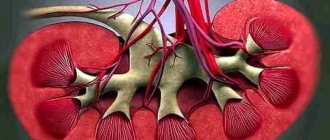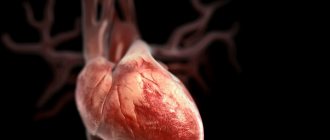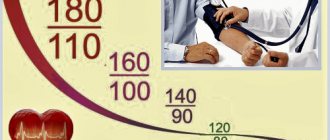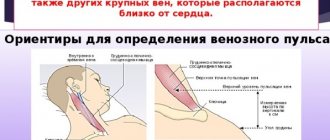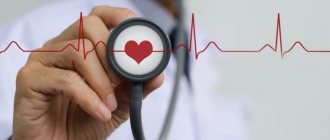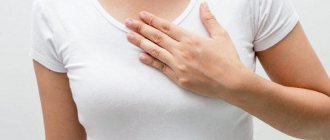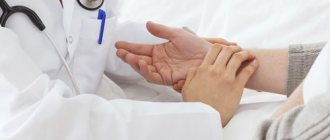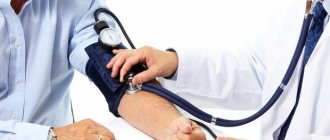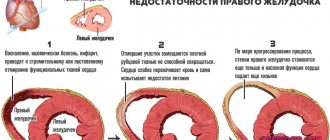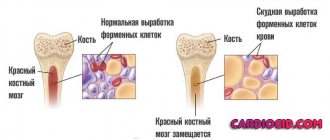A slow heartbeat that occurs when the pulse rate (i.e., heart rate) is low is called bradycardia, arrhythmia, or cardiac arrhythmia. Every day, a healthy heart beats about 100,000 times, at a rate of about 60 to 100 times per minute. What to do if your heart rate is below 50 beats per minute, and how to increase your low heart rate - let's try to figure it out.
Changes in heart rate caused by activity, diet, medications and age are normal and common, but if the heart rate decreases without the above-mentioned causes being present, it may indicate a health problem that requires emergency care or a visit to a specialist.
Etiology of the condition
When measuring the pulse, a clinical specialist counts the number of beats and the degree of filling of the arterial vessel.
These parameters are directly related to the work of the heart, in particular the cardiac cycle. A low heart rate of 50 beats per minute or less indicates a malfunction in the main muscular organ. The heart of an adult healthy person beats at an average frequency of 70-80 beats per minute. A pathological condition in which the heart rate is less than 60 beats is called bradycardia in clinical practice. A detailed study of the pathology made it possible to identify its most common causes. They are divided into two fundamentally different categories: physiological and pathological.
Natural causes
Physiological causes of bradycardia are associated with some natural human conditions:
- The state of sleep is marked by a decrease in the activity of all organs and systems. The pulse of a sleeping person also slows down. During awakening from sleep, morning bradycardia may persist, which should be regarded as a variant of the norm.
- A pulse below 60 is observed during hypothermia. An active decrease in body temperature is accompanied by reduced oxygen consumption, which slows down the activity of the cardiovascular system.
- A low heart rate is typical for professional athletes. Constant physical activity hypertrophies the heart muscle. At rest, it relaxes and contracts less frequently.
- Decreased heart rate may be inherited from parents and immediate family. At the same time, a decreased metabolism and some other physiological characteristics are observed.
- The cause of low heart rate may be the physiological state of pregnancy. The growing uterus compresses the inferior vena cava, which leads to more rare contractions of the heart muscle.
Pathological causes
Another group of causes of bradycardia is a consequence of certain diseases or disorders. They are referred to as pathological:
- Atherosclerotic vascular damage is observed in almost every person after 30 years. This causes a decrease in heart rate due to pathological narrowing of blood vessels and reduced blood flow to the heart.
- Myocardial infarction is dangerous not only due to the necrosis of a section of the heart muscle, but also the formation of a rough scar. It does not allow the heart to contract adequately to the needs of the body, a manifestation of which is a rare pulse.
- Viral infection of the myocardium, in particular myocarditis, can also cause dysfunctional heart function.
- Sick sinus syndrome is another reason for a rare pulse. Bradycardia develops against the background of pathology of nerve conduction in the heart muscle.
- Myocardial dystrophies and congenital anomalies in the structure of the heart are less common, but also cause pathological conditions with a rare pulse.
The above-described causes of bradycardia are directly related to the heart and myocardium in particular. However, some diseases not related to the cardiovascular system can also slow down the pulse:
- Bradycardia usually accompanies any intoxication of the body. Ethanol and its metabolites, lead, and organic compounds with phosphates circulating in the blood have a toxic effect on organs. General intoxication is a symptom of diseases such as hepatitis, uremia, sepsis, typhoid fever, which are always manifested by a rare pulse of less than 60 beats per minute.
- Reduced thyroid function or hypothyroidism is manifested by a slowdown in the functioning of all organs and systems. Bradycardia in this case is combined with hypotension, asthenia, and lethargy.
- Hypercalcemia blocks the normal pulse due to the antagonistic effect of calcium and potassium. The last microelement is necessary for normal myocardial contraction, however, due to its calcium block, heart activity is reduced.
- Increased intracranial pressure invariably leads to bradycardia. In this case, the depressive effect is on the higher nerve centers, which is why the pulse decreases. The condition is observed with inflammatory damage to the brain, intracerebral hemorrhages, and oncological pathologies.
If a person does not feel unwell from a pulse of 50 beats per minute, there is no sufficient reason to worry. But bradycardia should not always be ignored, especially if it is accompanied by additional symptoms.
When you need urgent medical help
If your heart rate is low, what should you do? A sharp decrease in heart rate and blood pressure may indicate a critical condition that requires urgent help from specialists.
These conditions include:
- Pulmonary embolism (a condition during which an artery is blocked by a blood clot). This cause of disruption of the normal pulse is considered the most common and most dangerous.
- Fainting and collapse. Such conditions arise as a result of certain diseases: anemia, metabolic diseases, difficulties with the functioning of the nervous system. Fainting can occur due to excessive physical exertion on the body, prolonged stress, an exhausting diet, or overheating.
- Excessive blood loss and development of bleeding. With blood loss, pulse and blood pressure decrease significantly. In this case, one should consider not only external, but also internal bleeding - gastric, pulmonary.
- Intoxication of the body and infections. Such lesions negatively affect the body, leading to a decrease in blood pressure and heartbeat.
- Allergies. Quincke's edema is the most common allergic reaction, during which two indicators decrease at once: the patient's blood pressure and pulse. Quincke's edema appears when taking certain foods, chemicals or medications.
- Arrhythmia. Cardiac arrhythmia includes a large number of diseases of the cardiovascular system. Most often, in this case, a pathological decrease in pulse and pressure is combined, which requires emergency surgery - implantation of an pacemaker.
- Acute myocardial infarction. Leads to a decrease in blood pressure and heart rate, which results in severe chest pain. Such a lesion requires immediate transport of the patient to the hospital and long-term treatment.
What to do if your heart rate is low: medications, folk remedies
- First, you should find out the recommendations of a cardiologist. The specialist will prescribe the necessary diagnostics in the current situation - an electrocardiogram.
- Sometimes Holter monitoring (24-hour heart diagnosis using a portable electrocardiograph), special tests with atropine, ultrasound examination of the heart, and coronary angiography may be needed.
- If cardiac pathology is not detected, you need to consult with other specialists (therapist, endocrinologist, neurologist...) to identify the causes of low heartbeat.
- During low pulse counts, drug therapy involves the use of Atropine sulfate. This remedy increases the number of heart contractions. If the patient has glaucoma, the drug is contraindicated for use.
- To stimulate brain function, experts recommend Izadrin.
- During acute attacks of bradycardia, therapy is carried out with Ipratropium. This remedy reduces the production of hormonal glands and does not affect the functioning of the brain. The effect of the drug occurs after 2 hours.
- In the presence of glaucoma or stenosis in the gastrointestinal tract, therapy is done with Orciprenaline. It is carried out under the supervision of a specialist, as the drug may cause side effects.
It is possible to raise a low heart rate at home. To achieve maximum effect, you should consult with a cardiologist in advance.
It is permissible to use folk remedies only when the cause of bradycardia has been established:
- to normalize the number of pulse beats through the use of honey and radish. For these purposes, you need to cut the radish in half and make a small hole in the middle with a knife. Put 1 teaspoon of honey inside and leave the radish overnight. The finished syrup will be the daily dosage; it needs to be divided into two or three times.
- to restore heart rhythm through the use of lemon and garlic. To prepare the recipe, you will need approximately 5 lemons and 5 heads of garlic. Squeeze the lemon juice and chop the garlic cloves as finely as possible. Mix the ingredients and mix with 400 g of honey. Take 2 tablespoons of the mixture before meals for 30 days.
- to eliminate bradycardia at home using walnuts. Peel 0.5 kg of nuts and chop. Add to them 0.25 kg of sugar and 200 ml of sesame oil. Take 2 tablespoons three times a day.
- The symptoms of bradycardia can be eliminated by tincture of alcohol and young pine shoots. Pour 300 ml of alcohol into the shoots. Let it brew for 10 days in a cool, dark place. Take 20 drops twice a day.
- Mustard baths are done to raise the pulse . For these purposes, add 150 g of mustard powder to the prepared bath. It is permissible to carry out the procedure daily for 15 minutes. Helps improve blood flow to the heart muscles and increases heart rate.
- Boil 3 tablespoons of rose hips in 400 ml of water for 15 minutes. Cool the resulting broth and strain through gauze, which must be folded in several layers. Add 3 tablespoons of honey. You need to consume half a glass twice a day.
- to quickly eliminate bradycardia using ordinary mustard plasters. They need to be placed on the chest. The burning sensation will stimulate blood flow, which will increase the number of pulse beats.
How does the stimulant work?
The generator of this mini-device (implanted under the collarbone) sends signals to an electrode placed in the right atrium or right ventricle of the heart, forcing it to contract.
People with healthy hearts can tolerate bradycardia well. However, if the condition of this organ and the circulatory system in general (for example, cerebral arteries) leaves much to be desired, then the low heart rate and interruptions in its work not only worsen life, but pose a direct threat to it if measures are not taken in time.
Treatment is based on implantation of a pacemaker. This small device consists of a battery-powered pulse generator and electrodes. The generator is inserted under the skin near the collarbone, usually on the left side, and an electrode or electrodes are inserted into the right atrium and/or right ventricle, depending on where the rhythm disturbance occurs. Most often they are placed in both chambers of the heart, because... this ensures a natural sequence of contractions between the atria and ventricles.
The electrodes conduct impulses from the generator into the heart chambers, and back they receive information about its natural contractions. The device is "intelligent". It constantly monitors the contractions of the heart muscle and sends electrical impulses only when they are needed.
The stimulator may have another unusual property - it adjusts the frequency of stimulation to the needs of the body, so it speeds up the heart rate during physical activity and slows it down during rest.
Installation of a pacemaker ties the patient to a cardiologist for life. Monitoring visits are required every 6-12 months, battery replacement after 4-7 years (depending on how often the device is turned on), sometimes also electrodes or reprogramming (for this you do not need to remove it from under the skin). These certain inconveniences are compensated by the comfort of life and its extension for many years.
Causes of rare pulse
Conventionally, the causes of bradycardia can be divided into 3 groups: physiological, pathological cardiac, pathological non-cardiac. If we talk about physiological factors leading to a decrease in heart contractions, these include:
- Hypothermia, in which the heart reflexively begins to beat less frequently because the body requires less oxygen under hypothermia conditions.
- Body fitness, such as that of athletes. Their heart muscle gets so used to the stress that in a calm state it simply relaxes.
- Heredity, which determines the individual physiological characteristics of the organism.
Sinus node and heart blocks
Sinus node disease and heart block are the two main types of disorders that cause bradycardia. The first is associated with insufficiency of the natural pathogen - the sinoatrial node. It generates impulses too rarely compared to the body's needs or may interrupt their generation for some time.
It also happens that the natural exciter works flawlessly, but the impulses it sends are inhibited or blocked in the conduction pathways: in the atrioventricular node, the bundle of His or its legs. This condition is called heart block or atrioventricular block. There are three degrees of it.
Causes of low heart rate
Even a healthy person experiences bradycardia. This happens at night or in the morning, when the body is just adjusting from sleep to wakefulness. This is not a pathology. A slight drop in heart rate is also considered normal in athletes. The heart, accustomed to excessive stress, slows down its contractions in a state of rest.
A congenital slow heart rate is not dangerous for people. This is an individual feature of the body.
If the pulse decreases, no treatment is required. The pulse in such situations recovers on its own.
Significantly affect the decrease in heart rate:
- Atherosclerosis. Due to blockage of large vessels, blood circulation slows down.
- Endocarditis. The development of inflammatory processes inside the lining of the heart.
- Hypotension. As a result of a decrease in blood pressure, there is insufficient pressure on the vascular walls.
- Myocarditis. Inflammation of the heart muscle.
- Myocardial infarction. An irreversible cessation of cell viability in the heart muscle occurs, and coronary blood flow stops due to injury to the venous arteries.
External factors causing low heart rate:
- heart drug abuse;
- poisoning of the body with nicotine or lead;
- exhausting diets;
- hypothermia;
- infectious diseases;
- change in weather conditions;
- emotional stress.
Strong emotions can affect your heart rate
Weak heartbeats are possible during pregnancy. This usually happens in later stages as a result of fetal pressure on the pudendal vein.
To exclude possible heart pathologies, it is important for a pregnant woman to consult a doctor.
As you age, your heart rate increases. In an elderly person, 70–100 beats per minute is considered normal. Therefore, even a slight decrease in heart rate can provoke a worsening of the condition (dizziness, loss of coordination, blurred vision, migraine).
Despite the general indicators of a normal pulse, everything depends on the individual characteristics of the human body and his lifestyle. If during bradycardia there is no heaviness or pain from the heart, there is no lethargy, drowsiness or other discomfort in the general condition, then a low pulse does not harm health.
Does heart rate depend on blood pressure?
Heart rate variability with normal, low and high blood pressure are closely related.
At normal blood pressure (from 110 to 70 to 130 to 80), the number of heart contractions should not exceed 60–90 beats in 60 seconds.
The following factors can provoke such a decrease:
- taking medications that affect the heart muscle;
- nervous overstrain;
- heavy physical activity that is unusual for the body.
Most often, a rare pulse with normal blood pressure is restored on its own and does not require additional measures.
But high blood pressure and a slow heart rate should alert you.
The reasons for the combination of these indicators may be:
- cardiosclerosis;
- inflammation of the outer lining of the heart;
- ischemia;
- oncology (in rare cases).
If, with hypertension and a small pulse, lethargy, nausea, and pain in the heart are observed, it is important to immediately call an ambulance. Bradycardia with hypotension is a sign of negative processes in the body. The cause of a slow heartbeat is often diseases of the nervous or endocrine system, the development of respiratory arrhythmia in children, and meningitis.
Important! Before the doctor arrives, it is dangerous to make your own choice of medications, as this can cause serious complications.
How to increase your heart rate without increasing your blood pressure
It happens that the pulse rate slows down, but the pressure remains normal. There are effective methods that make it possible to quickly restore normal heart rhythm and not affect blood pressure.
- Use mustard plaster. Mustard plaster should be applied to the right side of the chest. Its action will stimulate the heart muscle and speed up blood circulation, but will not affect blood pressure.
- Massage. It is necessary to massage the earlobes for 1-2 minutes. Then make extension and flexion movements with your left hand, and then stroke your hand for 3-5 minutes. This massage helps well with painful sensations in the heart.
- Take the medicine that was previously prescribed by your doctor. If a person experiences a decrease in heart rate for the first time and the doctor has not previously prescribed anything, then self-administration of medications is prohibited. This can have a detrimental effect on your health.
Massaging your earlobes will help increase your heart rate.
These methods will help temporarily alleviate a person’s condition. After your heart rate returns to normal, it is important to go to the hospital and undergo an examination to determine the cause of the slow heartbeat.
Main symptoms
Of course, it is quite difficult to determine the development of such a condition during pregnancy, but in a newborn baby, the manifestation of a low heartbeat can be identified by clear signs. It is often detected before a sudden stop in breathing. When walking, especially on cold days, the child’s heartbeat slows down significantly when leaving the house.
Sinus bradycardia is considered especially dangerous, since when it occurs, the heart rate can drop to 70 beats per minute. Sometimes this indicates serious problems in the functioning of the heart (for example, congenital blockade). In this case, the child experiences the following symptoms:
- The baby freezes, his movement stops. In some cases, limb cramps occur.
- The skin becomes pale, then a bluish color appears on the integument.
- Breathing may stop, and in some cases the heart stops beating altogether.
If a pathologically low heartbeat (less than 100 beats per minute) is detected in an infant, you cannot wait until additional symptoms appear that will indicate the presence of the disease. In this case, it is important to take the child to the doctor as soon as possible and strictly follow all recommendations.
If your pulse is low, what to do at home
The range of diseases that are accompanied by bradycardia is quite wide - from cerebral edema to hepatitis.
Only a medical examination, primarily a cardiogram, will help determine the cause and prescribe the correct treatment.
However, measures taken before receiving medical help can reduce the negative impact on health, improve well-being, and in some cases, save a person’s life. Immediate first aid is necessary if a person suffering from bradycardia has lost consciousness or is in a pre-fainting state.
In this case, the main danger is cardiac arrest of the patient. Therefore, it is necessary to carry out resuscitation measures, consisting of indirect heart massage, before the ambulance arrives. These manipulations are carried out with the patient lying on a hard and flat surface.
In this case, the patient’s head must be raised, placing it on something fairly solid - a roller, a bag, rolled up clothes.
The massage is carried out by pushing the heels of the palms into the lower chest.
The force of the pushes should be moderate so as not to damage the ribs and organs, but they must be carried out quite sharply and intensely.
What can you do at home?
Small. It is necessary to consult a doctor as planned. If the contraction frequency drops to 30-40 beats per minute, or better yet before that, you cannot do without calling an ambulance. The first step is to call. Then stabilizing measures are shown.
- It is recommended to open a window or window. This will help provide the body with oxygen. Gas exchange is weakened due to insufficient blood circulation in the pulmonary circle. Hence the hypoxia. Increasing the concentration of O2 in the environment will have a beneficial effect on the condition.
- Take tincture of eleutherococcus or ginseng. They should be in the first aid kit. 30-35 drops, but not both together, but one or the other. This will help increase your heart rate by 10-15 beats per minute.
- Sit down, calm down. Do not lie down, there is a high probability of loss of consciousness, vomiting and/or asphyxia with fatal consequences.
- Loosen the collar, remove tight body jewelry. Pressure on the carotid sinus, which is located in the neck, provokes a further decrease in heart rate, which is similar to death with bradycardia, especially critical.
Wait for the doctors and briefly talk about your condition and well-being.
What you definitely shouldn't do:
- Do physical education. The heart cannot withstand such a change. If there is bradycardia, there is probably a functional, anatomical disorder. Overstimulation will cause it to stall. It's better to sit and move less.
- Eating. This is not possible because loss of consciousness is possible. Reflex vomiting, gastric asphyxia and death.
- Take any medications. Since there is a rare pulse and the blood pressure is normal, the use of specialized drugs such as caffeine is not recommended. Blood pressure will increase with incomplete heart rate correction. A selective approach is required. Moreover, under dynamic monitoring using hardware methods.
- Take a shower and wash with cold water. Narrowing of facial vessels can lead to reflex stenosis of the coronary arteries that supply the heart. This is fraught with a heart attack or asystole.
It is recommended to agree to hospitalization. It is necessary to find out the reason for the deviation.
Treatment
If necessary, drug treatment is prescribed by a doctor after a full examination and careful collection of an anamnesis (history of the disease). The sympathomimetic Izadrin is sometimes used, but it is prescribed with caution due to side effects associated with the possibility of provoking other rhythm disturbances.
Courses of tinctures of Pantocrine, Eleutherococcus, Schisandra chinensis, and Ginseng help increase the heart rate. A slight decrease in heart rate will help increase black or green tea, and if there are no contraindications, a cup of natural coffee. The use of any medication or stimulant drink should be discussed with your doctor.
In cases of persistent severe bradycardia, the issue of surgical treatment is resolved - cardiac pacing. An electric pacemaker (pacemaker), or artificial pacemaker, helps regulate the heart rate in accordance with the specified parameters. External stimulation is carried out under the supervision of a doctor in a medical institution and is temporary in nature - it “tunes” the heart to work at the desired rhythm. If this method is ineffective and the patient’s condition is serious, internal cardiac stimulation is performed - an operation to implant a temporary or permanent pacemaker.
Causes of low heart rate
Even a healthy person experiences bradycardia. This happens at night or in the morning, when the body is just adjusting from sleep to wakefulness.
This is not a pathology. A slight drop in heart rate is also considered normal in athletes.
The heart, accustomed to excessive stress, slows down its contractions in a state of rest.
A congenital slow heart rate is not dangerous for people. This is an individual feature of the body.
If the pulse decreases, no treatment is required. The pulse in such situations recovers on its own.
Significantly affect the decrease in heart rate:
- Atherosclerosis. Due to blockage of large vessels, blood circulation slows down.
- Endocarditis. The development of inflammatory processes inside the lining of the heart.
- Hypotension. As a result of a decrease in blood pressure, there is insufficient pressure on the vascular walls.
- Myocarditis. Inflammation of the heart muscle.
- Myocardial infarction. An irreversible cessation of cell viability in the heart muscle occurs, and coronary blood flow stops due to injury to the venous arteries.
External factors causing low heart rate:
The normal pulse rate for people of different age groups is different; it ranges from 60 to 100 beats per minute. But it cannot be said that a one-time decrease to 50 beats per minute indicates pathology.
There are many reasons why values may deviate from the norm. These include:.
- disruptions in the functioning of the endocrine system;
- arterial hypertension;
- heart disease;
- bad habits;
- emotional stress;
- heavy physical activity, including sports;
- infectious diseases;
- head injuries;
- long-term use of medications;
- hypothermia;
- significant blood loss;
- long fasting.
The listed reasons affect changes in heart rate. Depending on the provoking factors, the following types of bradycardia can be distinguished:
- Absolute.
- Relative.
- Moderate.
- Extracardiac.
Doctors name the following reasons for low heart rate with normal blood pressure:
- increased pressure inside the skull;
- intoxication of the body, including poisons and chemicals;
- heart rate drops when taking certain medications;
- Neurological diseases can reduce heartbeat;
- infectious lesion;
- heart rate pathologies can slow down the heart rate;
- bruises of the chest, neck;
- pain syndrome, consequences of swimming in cold water.
The presence of blood pressure is a necessary condition for the functioning of the circulatory system. It is under its influence that blood is transported to various organs, first through large arteries and then through small capillaries.
Normally, the blood pressure of a healthy person is 120 to 80 mmHg. If this indicator is higher, we can say about the development of hypertension, that is, a significant increase in blood pressure.
Causes of pathology:
Why can the heartbeat increase normally?
- physical exercise,
- stressful situation,
- strong positive or negative emotions.
A rapid pulse with normal blood pressure may be a sign of the following abnormalities:
- infectious diseases,
- neuroses,
- improper functioning of the thyroid gland,
- anemia,
- osteochondrosis.
When the pulse slows to 50 beats per minute, a person begins to feel weak, dizzy, cold sweat appears, and fainting is possible. Due to the fact that the heart begins to slowly pump blood, the brain experiences oxygen starvation.
There have been cases when fainting when the pulse slowed led to cardiac arrest.
Signs of bradycardia:
- The presence of a decreased pulse may be indicated by the patient’s personal sensations. These include frequent dizziness, weakness, and faintness.
- An electrocardiogram shows a decrease in the number of heartbeats as the intervals between them increase.
- Carrying out Holter monitoring throughout the day.
Diagnostic methods
It is quite simple to determine the problem in yourself; you just need to place your fingers on the inside of the hand or the upper part of the neck in the area of the artery. After finding the pulse, you need to count the number of heartbeats per minute. Not only changes in heart rate worry the patient, but also a number of other symptoms:
- Weakness, dizziness, sometimes interruptions in muscle function are felt, it seems to freeze.
- Sleep problems, memory impairment.
- Angina pectoris, heart failure, convulsions and loss of consciousness - these signs develop in severe cases when the low pulse is pathological in nature and develops suddenly. These symptoms develop under the influence of hypoxia.
- Due to impaired cerebral circulation, consciousness often becomes clouded and severe dizziness appears.
Rare pulse with normal blood pressure, what to do?
The attending doctor decides how to raise the heart rate with medication. Pharmacotherapy is selected individually for a particular patient, taking into account existing pathologies, the severity and cause of bradycardia.
The most commonly used groups of drugs:
- sympathomimetics (adrenergic agonists);
- M-anticholinergics;
- methylxanthines.
Taking special medications is indicated when the heart rate drops to 40-38 beats per minute or less.
Bradycardia may appear in a person suffering from peptic ulcer, cholelithiasis or urolithiasis, acute glomerulonephritis, or in a patient with a sliding hernia of the esophageal diaphragmatic opening, mass mediastinal tumors, or traumatic brain injuries.
All of these drugs have a short-term effect and are used as emergency medications. There are currently no medications that can consistently increase heart rate without affecting blood pressure and without side effects on other organs and systems. That is why, with a systematic decrease in the frequency of contractions of the heart muscle, it is imperative to look for the cause of the disease. To do this, you need to consult a cardiologist, since the main measure for bradycardia is the diagnosis and treatment of the underlying pathology that causes it, and not taking drugs that temporarily increase the pulse.
However, there are situations where a low pulse with stable blood pressure is an isolated, transient case. In this case, you can increase your heart rate at home without the use of drugs.
In the absence of pathology, you can increase your heart rate by eating a piece of dark chocolate
Most often, the question “what to do if your heart rate is low at home?” Experts advise drinking strong sweet tea or coffee. However, it should be remembered that such a measure can lead to increased blood pressure, which is undesirable for hypertensive patients
This recommendation should also be taken with caution in patients with diabetes.
Several ways to increase your heart rate without medications:
- taking adaptogens, tonic tinctures (ginseng, hawthorn, rose hips, royal jelly, eleutherococcus, etc.);
- dosed physical activity;
- cold and hot shower;
- eating several slices of dark chocolate with a high cocoa content (72-75% or more).
Despite the fact that in most cases the listed methods demonstrate fairly high effectiveness, this does not mean that they are guaranteed to help cope with bradycardia.
Bradycardia is diagnosed when the frequency of contractions of the heart muscle decreases to numbers not exceeding 55–59 beats per minute.
If, against the background of a low pulse (even while maintaining the usual pressure), the patient is worried about a deterioration in health, all measures bring short-term relief or are ineffective, it is necessary to seek medical help.
Diagnostic procedures
If your heartbeat is weak, your doctor will prescribe a number of procedures to help determine the cause of the problem. First, the cardiologist measures the number of heart beats per minute and intracranial pressure. A hormone test is performed to determine if there are problems in the thyroid gland. Ultrasound of the adrenal glands is recommended. A mandatory stage is an ECG and ultrasound of the heart. These measures will help determine how the heart muscle works. If the cardiologist sees a need, he refers you for consultation to doctors in other fields of medicine.
Return to contents
Recommendations for bradycardia
To help a person, they use products that lower the pulse, physical exercise, and herbs, but subject to slight fluctuations in heart rate and when the victim’s condition is stable. If the patient gets worse, self-medication is prohibited.
Tonic drinks
Often, when people don’t know what to drink when their heart rate is low, caffeine-containing products, including strong black tea and coffee, are effective. Drinks are consumed with sugar or honey. Use tincture of ginseng and eleutherococcus to quickly influence the functioning of the heart muscle within 5 minutes.
Physical procedures
Often, with bradycardia, you can do without drug treatment if you constantly monitor your health. Values of 50 or 55 when measuring heart rate are raised with the help of simple physical exercises. Running, walking, swimming, and light warm-up are suitable for such purposes.
Hot baths are effective, as are mustard plasters and compresses on the back of the patient’s head. The warming effect of the procedures increases blood flow and heart rate, but the time for such manipulations is limited to 15 minutes for baths and 5 minutes for mustard plasters.
Add a few drops of essential oil to the bath water, for example pine oil. Suitable for the procedure is dry mustard in an amount of up to 200 grams, which is pre-diluted in a small amount of water.
Surgery
In case of an advanced form of the disease and in the absence of effect from complex drug therapy, surgery is prescribed. The patient is fitted with a special pacemaker, which is designed to control the functioning of the heart muscle.
When the numbers regularly drop to 50 and below, it is difficult to correct the situation without a special device. A modern clinic for the treatment of such diseases offers the patient high-quality services, and the price differs depending on the stage of the disease.
An innovative solution is correction using an electrical pacemaker. If the pulse is low, a sensor that is installed under the patient’s skin will tell you how to increase the readings. The operation does not harm the patient and allows daily monitoring of readings.
Healthy lifestyle
The following recommendations will help restore normal functioning of the cardiovascular system:
- healthy sleep;
- morning work-out;
- walks in the open air;
- daily contrast shower;
- balanced diet;
- proper meals throughout the day;
Daily physical exercise provided that your heart rate and blood pressure are low, including running, swimming, brisk walking, Nordic walking, and table tennis.
Important! If you find out in time why pathology occurs, and also constantly engage in prevention and strengthen the body, you can prevent many life-threatening diseases. .
Healthy lifestyle
Healthy lifestyle
Heart rate stimulator
Electrical stimulation of the heart involves initiating its contractions using external electronic devices.
The stimulator contains an electrical pulse generator, electrodes that transmit pulses and a microcomputer, which can be freely programmed, selecting individual settings for each specific patient. You can choose the heart rate, the strength and duration of the impulse, sensitivity and other parameters of its operation. Pacemaker implantation
The pacemaker implantation procedure is performed under local anesthesia. The electrode is inserted through a vein under the control of an X-ray machine, into the right ventricle, and sometimes into the right atrium.
During the implantation operation, measurements of heart parameters are taken to allow the device to be programmed correctly. The stimulator itself is implanted subcutaneously under the collarbone.
A patient with an implanted pacemaker should undergo routine annual examinations. Unfortunately, having an implanted system carries a certain risk of complications.
The most common are:
- movement of the electrode into the heart, causing disruption of pacing (in such a situation, another procedure is necessary);
- increasing the stimulation threshold (reprogramming the pacemaker is required);
- tachycardia (results from improper programming of the pacemaker);
- local infections: with weakened immunity, it can even lead to sepsis.
